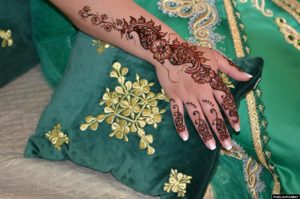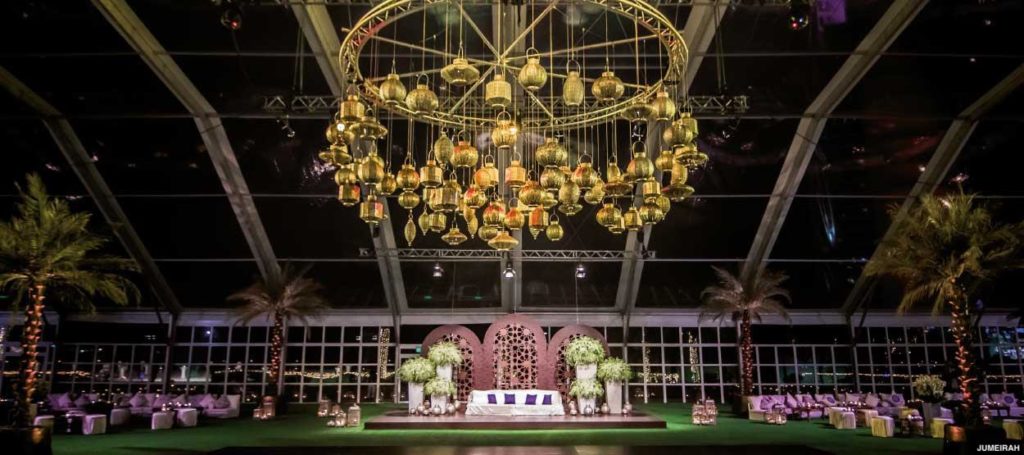Suddenly, the Room
Turned Black

SUE BRATTLE
When the Groom Drops In On (His Own) Wedding
I HAVE no photographs of the weddings of Dubai locals I’ve been to. You’re not allowed to take phones or cameras along, and only the official photographer can take pictures, which are made into albums for limited viewing.
This is because the women (and the guests are all female, of which more later) are dressed up to the nines, not covered head-to-toe in their everyday black, and so it would be shameful for the photographs to be circulated. Consequently, I have no record of any of the weddings I attended in the six years I lived in Dubai, so here’s my best shot at describing them.
You typically receive the beautiful and ornate invitation some weeks ahead of the big day; in fact nearly everything happens before the big day. The couple are married some days before, the dowry is haggled over and accepted, contracts completed and so on. In Dubai, where cousin marriage is common, cousin couples are obligated by law to have blood tests to rule out incompatibilities. So by the time friends and colleagues like me get involved, it’s pretty much a huge party – and I mean H-U-U-U-GE.
The first time a colleague where I worked in Dubai government invited me to her wedding, I felt quite moved to be on the guest list. Until I realised that just about every woman in the office was going as well. Brides invite everyone in their circle, family, friends, colleagues. So 750 to 1,000 guests isn’t uncommon. The rulers in the United Arab Emirates are trying to keep families from bankrupting themselves over such lavish hospitality. They even encourage mass weddings these days, with lots of couples sharing a celebration, and sharing the cost. But none of the brides I knew in my time in Dubai seemed to have any worries along those lines.
Typically nowadays the event is staged in one of Dubai’s many five-star hotels where the bride will take over a ballroom and have it decorated in her chosen colour or theme. The invitation will have given a hint at what that would be. When you arrive, a row of the bride’s senior female relatives is lined up to greet you, some wearing the traditional gold-coloured face mask, or burqa, for modesty as they are on a rare trip outside their home.
When you enter the ballroom, it’s hard not to gasp at the sheer extravagance of the setting. Flowers hanging from ceilings in baskets the size of an eight-person canoe; strings of pearls (not necessarily fake) draped over tabletops; napkins matched exactly to the design on the invitation. Unbelievable.

But first you have to find where your seat is in a room the size of a football pitch. It’s now you realise that you don’t recognise women you spend five days a week with, because they’re not covered. In fact, that’s putting it mildly; the guests are dressed in exquisite evening gowns (wedding receptions are always held in the late evening), their hair groomed into elaborate styles or hanging loose down to their waist. Beautiful jewellery and henna designs cover their hands, arms, and even feet. At my first Gulf wedding, I left home thinking I looked the bee’s knees and spent the evening feeling positively frumpy.
Once seated, with women shouting out my name and me struggling to think who they could be, the food starts to arrive. It’s lavish, there’s lots of it, and the last thing you do is actually eat it. A friend did me a favour before my first wedding by advising I eat a sandwich beforehand, and I noticed that most people were pushing a little food around their plate, then leaving almost all of it. This probably dates from a pre-oil time only 50-odd years ago when Gulf Arabs were largely nomadic and may only eat every two or three days. Now, in these times of plenty, what better way to display wealth than offer food no one needs to eat? Personally, I prefer to think the abstinence is in sympathy with the bride.
If I thought the guests looked splendid, an Emirati bride looks a million dollars – which may in fact be a pretty accurate estimate of her value in jewels and gold. Forget feeling comfortable on the day, a bride in Dubai is expected to hold her breath for seven or eight hours in a dress so fitted that sitting down is an art form. These concoctions are often made in Paris or London and are covered in jewels and pearls, making them so heavy the poor girl can hardly stand without help. And make-up is applied in layers, with vivid eye and lip colours and blusher that makes the bride look less blushing than like she’s running a temperature.

The bride processes into the ballroom once the guests are seated, doing a much longer walk than I did down the aisle of an English village church. She then climbs up steps onto a brightly-lit and beautifully decorated stage at one end of the ballroom, a process that in one case I couldn’t bear to watch in case the pearl-encrusted bride stumbled. She then sits alone throughout the proceedings as guests go up one-by-one for a photograph with her (female photographers only, of course) while the mother, aunts, and elderly relatives look on. Actually, they’re all casting a critical eye over the single females in the room, with a brief to find them a suitable husband when the groom makes his appearance with his mates later on (around midnight, usually). Before that, there’s the dancing…
Music is supplied by a live band and is of the mesmerising and haunting Arab style that I love. If the band is male, it’s hidden behind a huge partition covered in black velvet so us women have our modesty protected. If you are a rare foreigner in a sea of locals, all eyes are always on you to get up and dance. Well, it gives everyone a good laugh and is a way of working off all the calories you haven’t eaten. This goes on for ages, and is great fun. Have I mentioned yet what fun these weddings are? Up to a thousand women in one room dancing, singing, chatting, laughing, literally letting their hair down.
Then word goes out that the groom is arriving and suddenly, the room turns black.
Let me explain. You turn up at a Gulf wedding carrying your invitation in one hand, and a bag over your shoulder. That’s because you need to take your abaya and shaila (floor-length black cloak and long headscarf that you wrap around your head, chin and neck) for the moment when the groom and his party turn up for a few photographs before going away again. It takes 30 seconds to get covered once word goes out that the groom is at the ballroom door, then the men process through the hall, not having a clue what scenes of fun and mayhem they missed out on a minute earlier.
The groom, who has a decorative sheer cloak edged in gold over his floor-length white dish-dasha, joins his bride on the stage for photographs, and the elderly women get busy matchmaking. They’ll have a lot to discuss later in the week as families work out which young guy from the wedding party would suit which single girl best.

The men disappear quite quickly as they have their own, much smaller wedding dinner for about a dozen or so friends and relatives of the groom. Then it’s off with the abaya and back to dancing and feeling hungry, and drinking juice (strictly no alcohol, of course), and being introduced to everyone’s mum and grandmother, until you really can’t go on any more and it’s time to leave – 2 or 3am, typically.
The Gulf wedding season spans the cooler months from October to March, a tradition dating back from before air-conditioning. And since almost every Emirati girl gets married, it was never long before another invitation landed on my desk and the whole thing started all over again. Just in case you get such an invitation some day, my advice is to put on your very best party gown, don’t hold back on the jewellery, and eat something before you go. Whatever you do, don’t miss out on the opportunity to have the time of your life.
Top photo: Abayas come in all shapes and colours, but black is the winner
April 2019
RELATED
 THE QUEEN ELIZABETH 2, the much-loved liner that traversed the world’s oceans for nearly 40 years, has opened as a floating luxury hotel in Dubai, bringing a tortuous 10-year saga round full circle. READ MORE
THE QUEEN ELIZABETH 2, the much-loved liner that traversed the world’s oceans for nearly 40 years, has opened as a floating luxury hotel in Dubai, bringing a tortuous 10-year saga round full circle. READ MORE
 DUBAI IS A PLACE where there’s always something new to see – join us we visit 10 of them, including the QE2 Hotel, the wacky Dubai Frame, and our favourite bar in the city. READ MORE
DUBAI IS A PLACE where there’s always something new to see – join us we visit 10 of them, including the QE2 Hotel, the wacky Dubai Frame, and our favourite bar in the city. READ MORE
 GULF ARABS LOVE BIG CATS and other exotic animals, and many sheikhs have private zoos. Normally these places are strictly out of bounds, but Afaranwide managed to have a look inside. READ MORE
GULF ARABS LOVE BIG CATS and other exotic animals, and many sheikhs have private zoos. Normally these places are strictly out of bounds, but Afaranwide managed to have a look inside. READ MORE
 MORE THAN TEN YEARS HAVE PASSED since the dark clouds of the global financial meltdown started to gather above the sands and skyscrapers of Dubai… READ MORE
MORE THAN TEN YEARS HAVE PASSED since the dark clouds of the global financial meltdown started to gather above the sands and skyscrapers of Dubai… READ MORE
RECOMMENDED
 WELCOME TO OUR WORLD! Afaranwide’s home page – this is where you can find out about our latest posts and other highlights. READ MORE
WELCOME TO OUR WORLD! Afaranwide’s home page – this is where you can find out about our latest posts and other highlights. READ MORE
 TOP 10 ATTRACTIONS: Many of the world’s most popular tourists sites are closed because of the coronavirus crisis, but you can still visit them virtually while you’re self-isolating. READ MORE
TOP 10 ATTRACTIONS: Many of the world’s most popular tourists sites are closed because of the coronavirus crisis, but you can still visit them virtually while you’re self-isolating. READ MORE
 SHIMLA, QUEEN OF THE HILLS: Government officials once retreated to Shimla in the foothills of the Himalayas to escape India’s blazing hot summers. Now tourists make the same journey. READ MORE
SHIMLA, QUEEN OF THE HILLS: Government officials once retreated to Shimla in the foothills of the Himalayas to escape India’s blazing hot summers. Now tourists make the same journey. READ MORE
 TEN THINGS WE LEARNED: Our up-to-the-minute guide to creating a website, one step at a time. The costs, the mistakes – it’s what we wish we’d known when we started blogging. READ MORE
TEN THINGS WE LEARNED: Our up-to-the-minute guide to creating a website, one step at a time. The costs, the mistakes – it’s what we wish we’d known when we started blogging. READ MORE
 TROUBLED TIMES FOR EXPATS: Moving abroad can seem an idyllic prospect, but what happens when sudden upheavals or the inescapable realities of life intrude? READ MORE
TROUBLED TIMES FOR EXPATS: Moving abroad can seem an idyllic prospect, but what happens when sudden upheavals or the inescapable realities of life intrude? READ MORE
LET'S KEEP IN TOUCH!
Suddenly, the Room
Turned Black

SUE BRATTLE
When the Groom Drops In On (His Own) Wedding
I HAVE no photographs of the weddings of Dubai locals I’ve been to. You’re not allowed to take phones or cameras along, and only the official photographer can take pictures, which are made into albums for limited viewing.
This is because the women (and the guests are all female, of which more later) are dressed up to the nines, not covered head-to-toe in their everyday black, and so it would be shameful for the photographs to be circulated. Consequently, I have no record of any of the weddings I attended in the six years I lived in Dubai, so here’s my best shot at describing them.
You typically receive the beautiful and ornate invitation some weeks ahead of the big day; in fact nearly everything happens before the big day. The couple are married some days before, the dowry is haggled over and accepted, contracts completed and so on. In Dubai, where cousin marriage is common, cousin couples are obligated by law to have blood tests to rule out incompatibilities. So by the time friends and colleagues like me get involved, it’s pretty much a huge party – and I mean H-U-U-U-GE.
The first time a colleague where I worked in Dubai government invited me to her wedding, I felt quite moved to be on the guest list. Until I realised that just about every woman in the office was going as well. Brides invite everyone in their circle, family, friends, colleagues. So 750 to 1,000 guests isn’t uncommon. The rulers in the United Arab Emirates are trying to keep families from bankrupting themselves over such lavish hospitality. They even encourage mass weddings these days, with lots of couples sharing a celebration, and sharing the cost. But none of the brides I knew in my time in Dubai seemed to have any worries along those lines.
Typically nowadays the event is staged in one of Dubai’s many five-star hotels where the bride will take over a ballroom and have it decorated in her chosen colour or theme. The invitation will have given a hint at what that would be. When you arrive, a row of the bride’s senior female relatives is lined up to greet you, some wearing the traditional gold-coloured face mask, or burqa, for modesty as they are on a rare trip outside their home.
When you enter the ballroom, it’s hard not to gasp at the sheer extravagance of the setting. Flowers hanging from ceilings in baskets the size of an eight-person canoe; strings of pearls (not necessarily fake) draped over tabletops; napkins matched exactly to the design on the invitation. Unbelievable.

But first you have to find where your seat is in a room the size of a football pitch. It’s now you realise that you don’t recognise women you spend five days a week with, because they’re not covered. In fact, that’s putting it mildly; the guests are dressed in exquisite evening gowns (wedding receptions are always held in the late evening), their hair groomed into elaborate styles or hanging loose down to their waist. Beautiful jewellery and henna designs cover their hands, arms, and even feet. At my first Gulf wedding, I left home thinking I looked the bee’s knees and spent the evening feeling positively frumpy.
Once seated, with women shouting out my name and me struggling to think who they could be, the food starts to arrive. It’s lavish, there’s lots of it, and the last thing you do is actually eat it. A friend did me a favour before my first wedding by advising I eat a sandwich beforehand, and I noticed that most people were pushing a little food around their plate, then leaving almost all of it. This probably dates from a pre-oil time only 50-odd years ago when Gulf Arabs were largely nomadic and may only eat every two or three days. Now, in these times of plenty, what better way to display wealth than offer food no one needs to eat? Personally, I prefer to think the abstinence is in sympathy with the bride.
If I thought the guests looked splendid, an Emirati bride looks a million dollars – which may in fact be a pretty accurate estimate of her value in jewels and gold. Forget feeling comfortable on the day, a bride in Dubai is expected to hold her breath for seven or eight hours in a dress so fitted that sitting down is an art form. These concoctions are often made in Paris or London and are covered in jewels and pearls, making them so heavy the poor girl can hardly stand without help. And make-up is applied in layers, with vivid eye and lip colours and blusher that makes the bride look less blushing than like she’s running a temperature.

The bride processes into the ballroom once the guests are seated, doing a much longer walk than I did down the aisle of an English village church. She then climbs up steps onto a brightly-lit and beautifully decorated stage at one end of the ballroom, a process that in one case I couldn’t bear to watch in case the pearl-encrusted bride stumbled. She then sits alone throughout the proceedings as guests go up one-by-one for a photograph with her (female photographers only, of course) while the mother, aunts, and elderly relatives look on. Actually, they’re all casting a critical eye over the single females in the room, with a brief to find them a suitable husband when the groom makes his appearance with his mates later on (around midnight, usually). Before that, there’s the dancing…
Music is supplied by a live band and is of the mesmerising and haunting Arab style that I love. If the band is male, it’s hidden behind a huge partition covered in black velvet so us women have our modesty protected. If you are a rare foreigner in a sea of locals, all eyes are always on you to get up and dance. Well, it gives everyone a good laugh and is a way of working off all the calories you haven’t eaten. This goes on for ages, and is great fun. Have I mentioned yet what fun these weddings are? Up to a thousand women in one room dancing, singing, chatting, laughing, literally letting their hair down.
Then word goes out that the groom is arriving and suddenly, the room turns black.
Let me explain. You turn up at a Gulf wedding carrying your invitation in one hand, and a bag over your shoulder. That’s because you need to take your abaya and shaila (floor-length black cloak and long headscarf that you wrap around your head, chin and neck) for the moment when the groom and his party turn up for a few photographs before going away again. It takes 30 seconds to get covered once word goes out that the groom is at the ballroom door, then the men process through the hall, not having a clue what scenes of fun and mayhem they missed out on a minute earlier.
The groom, who has a decorative sheer cloak edged in gold over his floor-length white dish-dasha, joins his bride on the stage for photographs, and the elderly women get busy matchmaking. They’ll have a lot to discuss later in the week as families work out which young guy from the wedding party would suit which single girl best.

The men disappear quite quickly as they have their own, much smaller wedding dinner for about a dozen or so friends and relatives of the groom. Then it’s off with the abaya and back to dancing and feeling hungry, and drinking juice (strictly no alcohol, of course), and being introduced to everyone’s mum and grandmother, until you really can’t go on any more and it’s time to leave – 2 or 3am, typically.
The Gulf wedding season spans the cooler months from October to March, a tradition dating back from before air-conditioning. And since almost every Emirati girl gets married, it was never long before another invitation landed on my desk and the whole thing started all over again. Just in case you get such an invitation some day, my advice is to put on your very best party gown, don’t hold back on the jewellery, and eat something before you go. Whatever you do, don’t miss out on the opportunity to have the time of your life.
Top photo: Abayas come in all shapes and colours, but black is the winner
April 2019
RELATED
 THE QUEEN ELIZABETH 2, the much-loved liner that traversed the world’s oceans for nearly 40 years, has opened as a floating luxury hotel in Dubai, bringing a tortuous 10-year saga round full circle. READ MORE
THE QUEEN ELIZABETH 2, the much-loved liner that traversed the world’s oceans for nearly 40 years, has opened as a floating luxury hotel in Dubai, bringing a tortuous 10-year saga round full circle. READ MORE
 DUBAI IS A PLACE where there’s always something new to see – join us we visit 10 of them, including the QE2 Hotel, the wacky Dubai Frame, and our favourite bar in the city. READ MORE
DUBAI IS A PLACE where there’s always something new to see – join us we visit 10 of them, including the QE2 Hotel, the wacky Dubai Frame, and our favourite bar in the city. READ MORE
 GULF ARABS LOVE BIG CATS and other exotic animals, and many sheikhs have private zoos. Normally these places are strictly out of bounds, but Afaranwide managed to have a look inside. READ MORE
GULF ARABS LOVE BIG CATS and other exotic animals, and many sheikhs have private zoos. Normally these places are strictly out of bounds, but Afaranwide managed to have a look inside. READ MORE
 MORE THAN TEN YEARS HAVE PASSED since the dark clouds of the global financial meltdown started to gather above the sands and skyscrapers of Dubai… READ MORE
MORE THAN TEN YEARS HAVE PASSED since the dark clouds of the global financial meltdown started to gather above the sands and skyscrapers of Dubai… READ MORE
RECOMMENDED
 WELCOME TO OUR WORLD! Afaranwide’s home page – this is where you can find out about our latest posts and other highlights. READ MORE
WELCOME TO OUR WORLD! Afaranwide’s home page – this is where you can find out about our latest posts and other highlights. READ MORE
 TOP 10 ATTRACTIONS: Many of the world’s most popular tourists sites are closed because of the coronavirus crisis, but you can still visit them virtually while you’re self-isolating. READ MORE
TOP 10 ATTRACTIONS: Many of the world’s most popular tourists sites are closed because of the coronavirus crisis, but you can still visit them virtually while you’re self-isolating. READ MORE
 SHIMLA, QUEEN OF THE HILLS: Government officials once retreated to Shimla in the foothills of the Himalayas to escape India’s blazing hot summers. Now tourists make the same journey. READ MORE
SHIMLA, QUEEN OF THE HILLS: Government officials once retreated to Shimla in the foothills of the Himalayas to escape India’s blazing hot summers. Now tourists make the same journey. READ MORE
 TEN THINGS WE LEARNED: Our up-to-the-minute guide to creating a website, one step at a time. The costs, the mistakes – it’s what we wish we’d known when we started blogging. READ MORE
TEN THINGS WE LEARNED: Our up-to-the-minute guide to creating a website, one step at a time. The costs, the mistakes – it’s what we wish we’d known when we started blogging. READ MORE
 TROUBLED TIMES FOR EXPATS: Moving abroad can seem an idyllic prospect, but what happens when sudden upheavals or the inescapable realities of life intrude? READ MORE
TROUBLED TIMES FOR EXPATS: Moving abroad can seem an idyllic prospect, but what happens when sudden upheavals or the inescapable realities of life intrude? READ MORE
LET'S KEEP IN TOUCH!
Suddenly, the Room Turned Black
When the Groom Drops In On (His Own) Wedding

SUE BRATTLE
I HAVE no photographs of the weddings of Dubai locals I’ve been to. You’re not allowed to take phones or cameras along, and only the official photographer can take pictures, which are made into albums for limited viewing.
This is because the women (and the guests are all female, of which more later) are dressed up to the nines, not covered head-to-toe in their everyday black, and so it would be shameful for the photographs to be circulated. Consequently, I have no record of any of the weddings I attended in the six years I lived in Dubai, so here’s my best shot at describing them.
You typically receive the beautiful and ornate invitation some weeks ahead of the big day; in fact nearly everything happens before the big day. The couple are married some days before, the dowry is haggled over and accepted, contracts completed and so on.
In Dubai, where cousin marriage is common, cousin couples are obligated by law to have blood tests to rule out incompatibilities. So by the time friends and colleagues like me get involved, it’s pretty much a huge party – and I mean H-U-U-U-GE.
The first time a colleague where I worked in Dubai government invited me to her wedding, I felt quite moved to be on the guest list. Until I realised that just about every woman in the office was going as well. Brides invite everyone in their circle, family, friends, colleagues. So 750 to 1,000 guests isn’t uncommon.
The rulers in the United Arab Emirates are trying to keep families from bankrupting themselves over such lavish hospitality. They even encourage mass weddings these days, with lots of couples sharing a celebration, and sharing the cost. But none of the brides I knew in my time in Dubai seemed to have any worries along those lines.
Typically nowadays the event is staged in one of Dubai’s many five-star hotels where the bride will take over a ballroom and have it decorated in her chosen colour or theme. The invitation will have given a hint at what that would be. When you arrive, a row of the bride’s senior female relatives is lined up to greet you, some wearing the traditional gold-coloured face mask, or burqa, for modesty as they are on a rare trip outside their home.
When you enter the ballroom, it’s hard not to gasp at the sheer extravagance of the setting. Flowers hanging from ceilings in baskets the size of an eight-person canoe; strings of pearls (not necessarily fake) draped over tabletops; napkins matched exactly to the design on the invitation. Unbelievable.

But first you have to find where your seat is in a room the size of a football pitch. It’s now you realise that you don’t recognise women you spend five days a week with, because they’re not covered.
In fact, that’s putting it mildly; the guests are dressed in exquisite evening gowns (wedding receptions are always held in the late evening), their hair groomed into elaborate styles or hanging loose down to their waist.
Beautiful jewellery and henna designs cover their hands, arms, and even feet. At my first Gulf wedding, I left home thinking I looked the bee’s knees and spent the evening feeling positively frumpy.
Once seated, with women shouting out my name and me struggling to think who they could be, the food starts to arrive. It’s lavish, there’s lots of it, and the last thing you do is actually eat it. A friend did me a favour before my first wedding by advising I eat a sandwich beforehand, and I noticed that most people were pushing a little food around their plate, then leaving almost all of it.
This probably dates from a pre-oil time only 50-odd years ago when Gulf Arabs were largely nomadic and may only eat every two or three days. Now, in these times of plenty, what better way to display wealth than offer food no one needs to eat? Personally, I prefer to think the abstinence is in sympathy with the bride.
If I thought the guests looked splendid, an Emirati bride looks a million dollars – which may in fact be a pretty accurate estimate of her value in jewels and gold. Forget feeling comfortable on the day, a bride in Dubai is expected to hold her breath for seven or eight hours in a dress so fitted that sitting down is an art form.
These concoctions are often made in Paris or London and are covered in jewels and pearls, making them so heavy the poor girl can hardly stand without help. And make-up is applied in layers, with vivid eye and lip colours and blusher that makes the bride look less blushing than like she’s running a temperature.

The bride processes into the ballroom once the guests are seated, doing a much longer walk than I did down the aisle of an English village church. She then climbs up steps onto a brightly-lit and beautifully decorated stage at one end of the ballroom, a process that in one case I couldn’t bear to watch in case the pearl-encrusted bride stumbled.
She then sits alone throughout the proceedings as guests go up one-by-one for a photograph with her (female photographers only, of course) while the mother, aunts, and elderly relatives look on.
Actually, they’re all casting a critical eye over the single females in the room, with a brief to find them a suitable husband when the groom makes his appearance with his mates later on (around midnight, usually). Before that, there’s the dancing…
Music is supplied by a live band and is of the mesmerising and haunting Arab style that I love. If the band is male, it’s hidden behind a huge partition covered in black velvet so us women have our modesty protected. If you are a rare foreigner in a sea of locals, all eyes are always on you to get up and dance.
Well, it gives everyone a good laugh and is a way of working off all the calories you haven’t eaten. This goes on for ages, and is great fun. Have I mentioned yet what fun these weddings are? Up to a thousand women in one room dancing, singing, chatting, laughing, literally letting their hair down.
Then word goes out that the groom is arriving and suddenly, the room turns black.
Let me explain. You turn up at a Gulf wedding carrying your invitation in one hand, and a bag over your shoulder. That’s because you need to take your abaya and shaila (floor-length black cloak and long headscarf that you wrap around your head, chin and neck) for the moment when the groom and his party turn up for a few photographs before going away again.
It takes 30 seconds to get covered once word goes out that the groom is at the ballroom door, then the men process through the hall, not having a clue what scenes of fun and mayhem they missed out on a minute earlier.
The groom, who has a decorative sheer cloak edged in gold over his floor-length white dish-dasha, joins his bride on the stage for photographs, and the elderly women get busy matchmaking. They’ll have a lot to discuss later in the week as families work out which young guy from the wedding party would suit which single girl best.

The men disappear quite quickly as they have their own, much smaller wedding dinner for about a dozen or so friends and relatives of the groom.
Then it’s off with the abaya and back to dancing and feeling hungry, and drinking juice (strictly no alcohol, of course), and being introduced to everyone’s mum and grandmother, until you really can’t go on any more and it’s time to leave – 2 or 3am, typically.
The Gulf wedding season spans the cooler months from October to March, a tradition dating back from before air-conditioning. And since almost every Emirati girl gets married, it was never long before another invitation landed on my desk and the whole thing started all over again.
Just in case you get such an invitation some day, my advice is to put on your very best party gown, don’t hold back on the jewellery, and eat something before you go. Whatever you do, don’t miss out on the opportunity to have the time of your life.
Top photo: Abayas come in all shapes and colours, but black is the winner
April 2019
RELATED
 THE QUEEN ELIZABETH 2, the much-loved liner that traversed the world’s oceans for nearly 40 years, has opened as a floating luxury hotel in Dubai, bringing a tortuous 10-year saga round full circle. READ MORE
THE QUEEN ELIZABETH 2, the much-loved liner that traversed the world’s oceans for nearly 40 years, has opened as a floating luxury hotel in Dubai, bringing a tortuous 10-year saga round full circle. READ MORE
 DUBAI IS A PLACE where there’s always something new to see – join us we visit 10 of them, including the QE2 Hotel, the wacky Dubai Frame, and our favourite bar in the city. READ MORE
DUBAI IS A PLACE where there’s always something new to see – join us we visit 10 of them, including the QE2 Hotel, the wacky Dubai Frame, and our favourite bar in the city. READ MORE
 GULF ARABS LOVE BIG CATS and other exotic animals, and many sheikhs have private zoos. Normally these places are strictly out of bounds, but Afaranwide managed to have a look inside. READ MORE
GULF ARABS LOVE BIG CATS and other exotic animals, and many sheikhs have private zoos. Normally these places are strictly out of bounds, but Afaranwide managed to have a look inside. READ MORE
 MORE THAN TEN YEARS HAVE PASSED since the dark clouds of the global financial meltdown started to gather above the sands and skyscrapers of Dubai… READ MORE
MORE THAN TEN YEARS HAVE PASSED since the dark clouds of the global financial meltdown started to gather above the sands and skyscrapers of Dubai… READ MORE
RECOMMENDED
 WELCOME TO OUR WORLD! Afaranwide’s home page – this is where you can find out about our latest posts and other highlights. READ MORE
WELCOME TO OUR WORLD! Afaranwide’s home page – this is where you can find out about our latest posts and other highlights. READ MORE
 TOP 10 ATTRACTIONS: Many of the world’s most popular tourists sites are closed because of the coronavirus crisis, but you can still visit them virtually while you’re self-isolating. READ MORE
TOP 10 ATTRACTIONS: Many of the world’s most popular tourists sites are closed because of the coronavirus crisis, but you can still visit them virtually while you’re self-isolating. READ MORE
 SHIMLA, QUEEN OF THE HILLS: Government officials once retreated to Shimla in the foothills of the Himalayas to escape India’s blazing hot summers. Now tourists make the same journey. READ MORE
SHIMLA, QUEEN OF THE HILLS: Government officials once retreated to Shimla in the foothills of the Himalayas to escape India’s blazing hot summers. Now tourists make the same journey. READ MORE
 TEN THINGS WE LEARNED: Our up-to-the-minute guide to creating a website, one step at a time. The costs, the mistakes – it’s what we wish we’d known when we started blogging. READ MORE
TEN THINGS WE LEARNED: Our up-to-the-minute guide to creating a website, one step at a time. The costs, the mistakes – it’s what we wish we’d known when we started blogging. READ MORE
 TROUBLED TIMES FOR EXPATS: Moving abroad can seem an idyllic prospect, but what happens when sudden upheavals or the inescapable realities of life intrude? READ MORE
TROUBLED TIMES FOR EXPATS: Moving abroad can seem an idyllic prospect, but what happens when sudden upheavals or the inescapable realities of life intrude? READ MORE